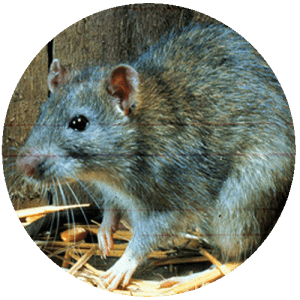The Norway Rat, a relatively large rat, has successful adapted to Metro Vancouver

A hardy, aggressive, adaptable and sly animal. The Norway Rat has garnered more attention through urban myths than any other rat species. It’s called sewer rat, barn rat or even super rat depending on the region. These names indicate this animal impact on North American culture.
In the 1770s Norway Rat came to America with European Settlers and on trading ships. By 1827 the Norway Rat was a common sight in the eastern states. Today it thrives all-over North America.
Identification
The Norway Rat is relatively large. On average measuring 16 inches (41 cm) in length and weighing 12 to 16 ounces (340 g). Popular media often exaggerates the size of this rat. At first glance, one would notice the Norway rat’s tail is shorter than its body. Also, its snout is less pronounced than other rat species. This rat’s fur colour can vary from brown, white to pure gray or reddish-brown. Therefore, one can’t identify the animal on fur colour alone.
Reproduction
Norway Rats breed in the fall and spring with breeding decreases in the summer and winter. This breeding pattern is subject to climate and sanitation of their environment. Gestation lasts for 22 days. A female will produce a litter of about 8 to 12 pups. The pups will then reach sexual maturity in eight to twelve weeks. A Norway Rat can live up to 3 years in captivity, but only live from 5 to 12 months in the wild
Habitat
The Norway rat is, by nature, a ground-dwelling mammal, constructing its nest within subterranean burrows. They will often begin their burrows near heavy or large rocks, alongside building foundations and beneath slabs. Burrowing or nest-building behaviours can also be triggered (stimulated) by clutter, which further stresses the need to keep areas clutter-free. In addition to the entrance, they will also have one or two escape holes for a quick emergency exit.
Food Source
This rat is an opportunistic foraging omnivore. Eating almost anything it encounters including: human refuse, grain, insects or any other natural food. However, they tend to display “neophobic” tendencies. And often avoid new foods that suddenly appear, including bait!
Norway Rats are most active during dusk and just prior to dawn. But will forage several times over the course of a 24-hour period.
- Rat Fact:
- The Norway rat often referred to as a sewer rat, barn rat or even a super rat …
Solutions Pest Control
Pest Education Experts
Our knowledgeable pest detectives are ready to answer your questions (during office hours). We are happy to talk to people and walk them through the steps to identify the pest issue and determine if a service call will give them peace of mind.
We will spend will as much time as needed, to educate you on the signs and characteristics of the most common pests.



